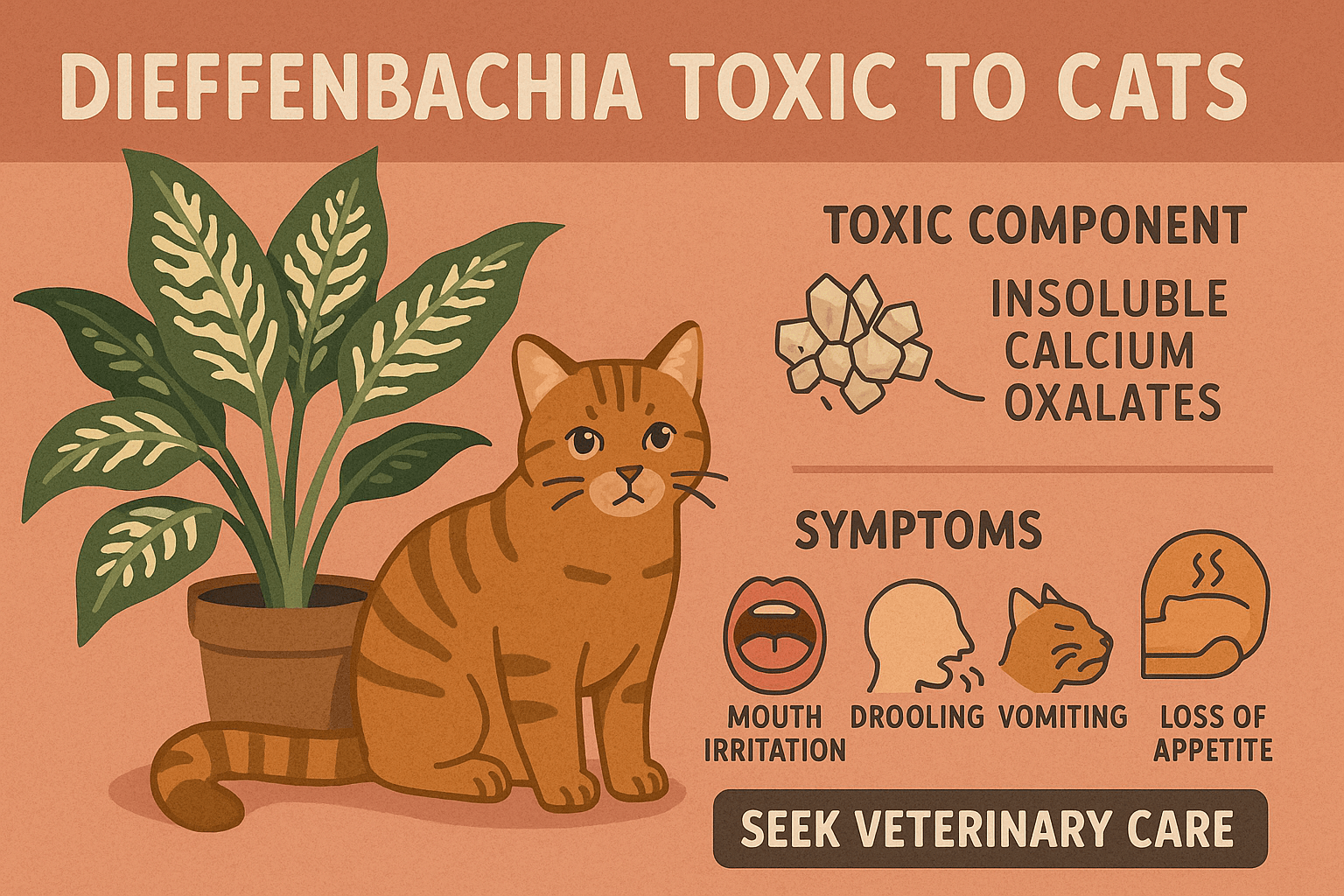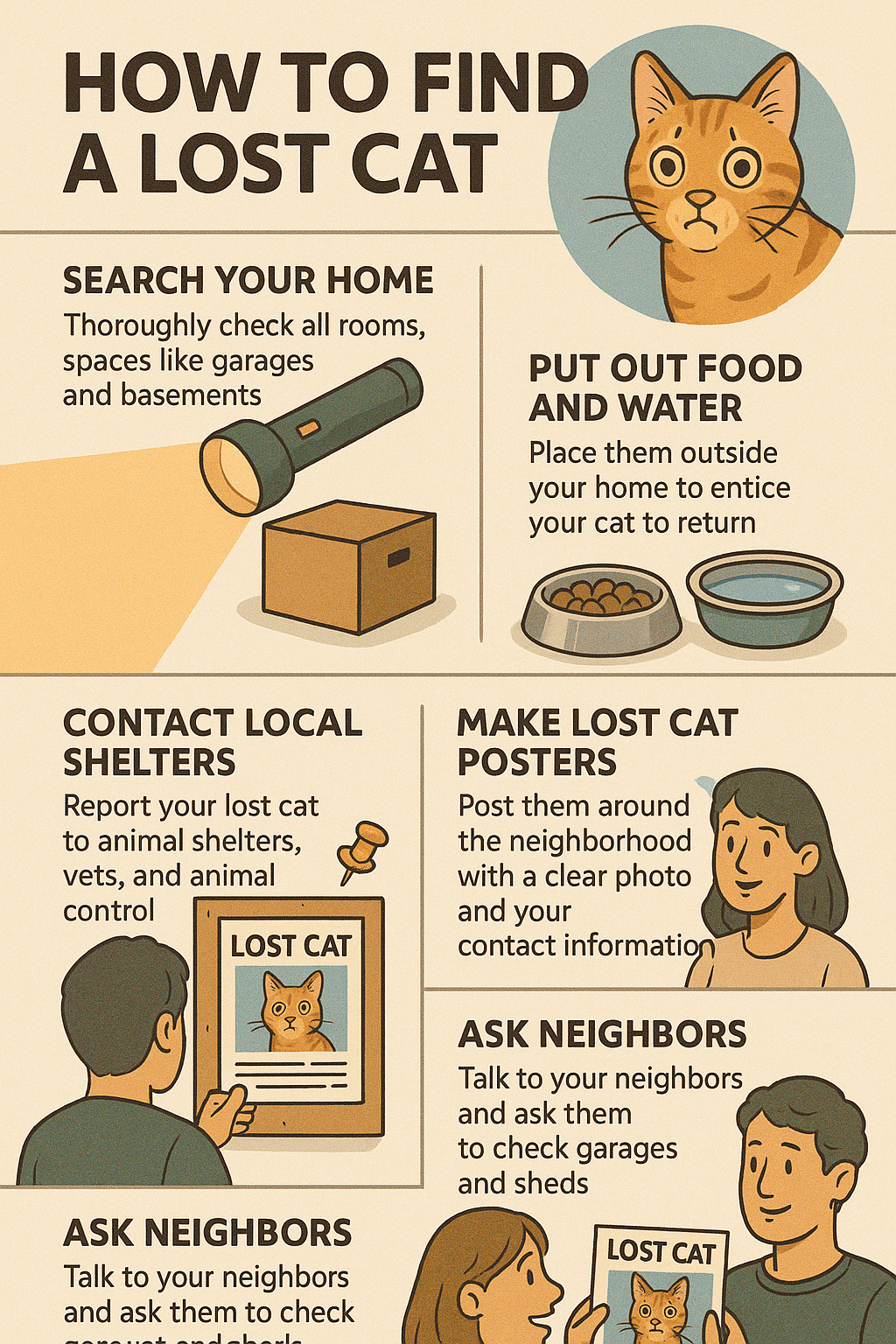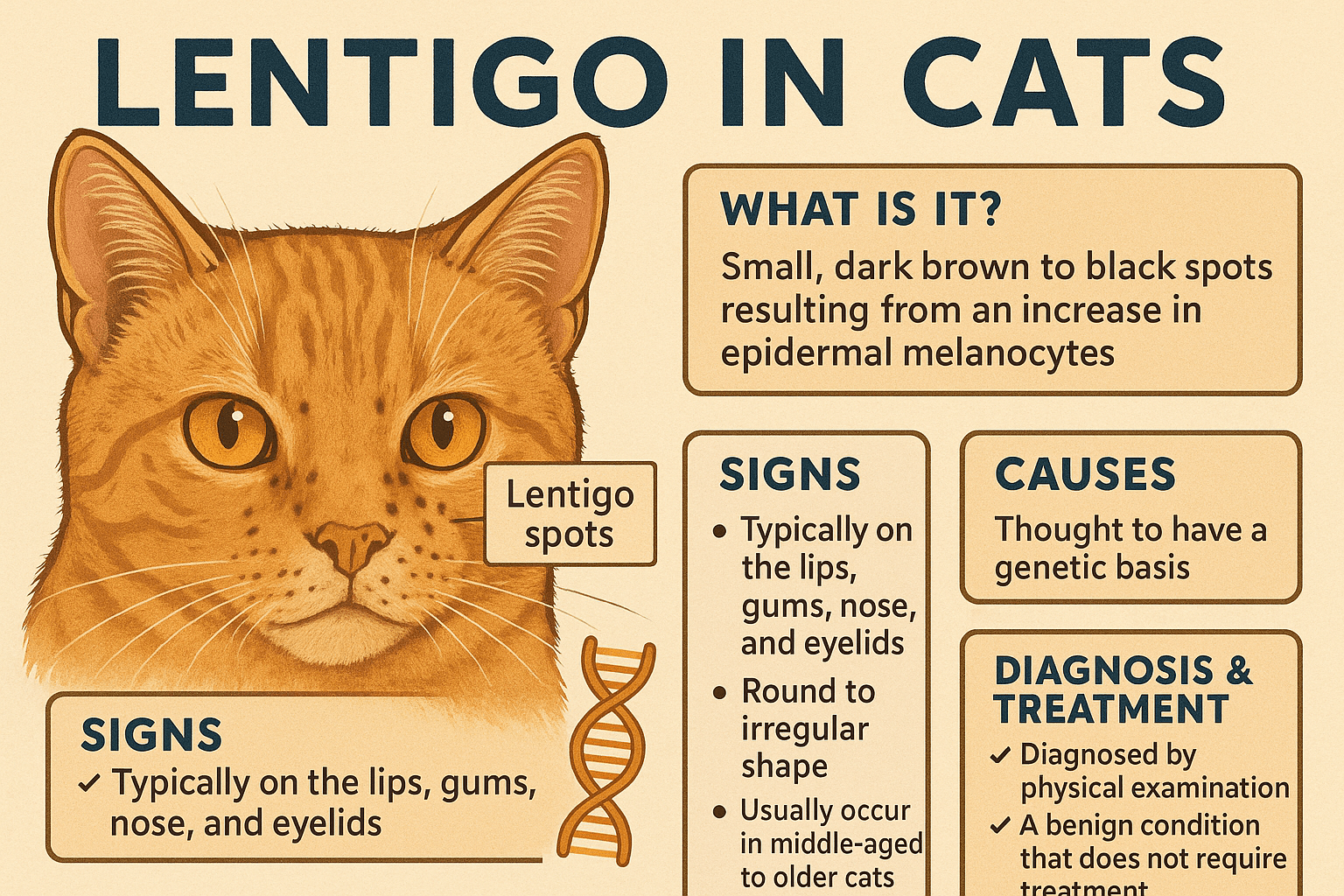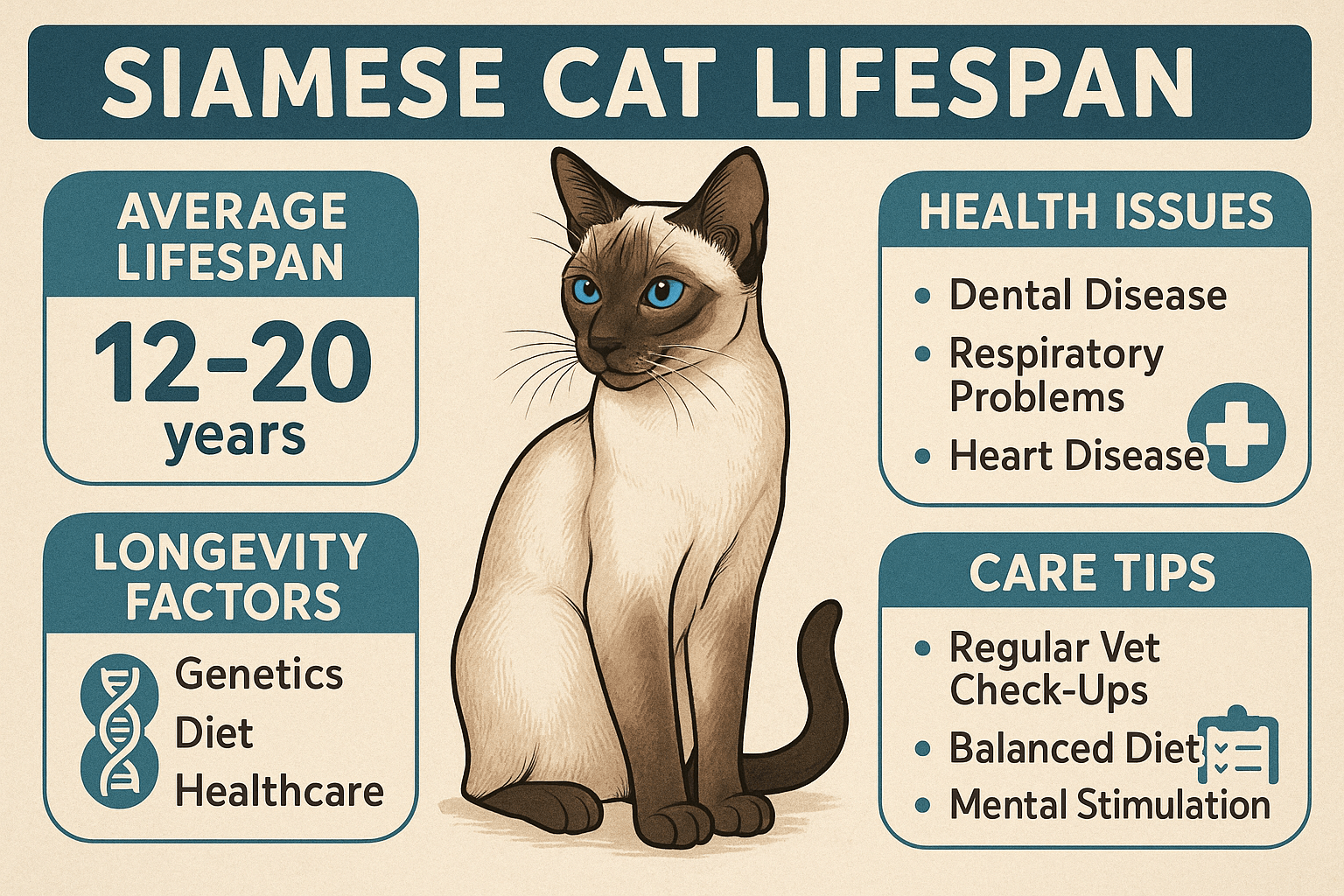Is Dieffenbachia Toxic to Cats? What You Need to Know
Dieffenbachia, commonly known as dumb cane, is a popular houseplant admired for its lush foliage and easy maintenance. However, this seemingly harmless plant hides a dangerous secret—it’s toxic to cats. If your feline friend takes a curious nibble of its leaves, it could lead to serious health issues. Understanding the risks associated with Dieffenbachia and learning how to keep your cat safe is essential for every pet owner. In this blog post, we’ll explore why Dieffenbachia is harmful, how to identify symptoms of poisoning, and what steps to take if your cat comes into contact with this plant. Let’s dive in and ensure your home remains a safe haven for your furry companion.
Why Is Dieffenbachia Toxic to Cats?
The toxicity of Dieffenbachia lies in its sap, which contains calcium oxalate crystals. These sharp, needle-like structures can cause significant irritation and pain when ingested or even touched. Here’s a breakdown of why this plant poses such a threat to cats.
Calcium Oxalate Crystals:
When chewed or ingested, these crystals penetrate the soft tissues of a cat’s mouth, throat, and digestive system, causing intense irritation.Immediate Oral Pain:
The crystals trigger a burning sensation in the mouth, often leading to drooling, pawing at the face, or vocalizing in discomfort.Swelling of the Mouth and Tongue:
Severe swelling can make it difficult for your cat to breathe or swallow, posing a potential emergency situation.Gastrointestinal Upset:
If swallowed, the toxins can irritate the stomach and intestines, resulting in vomiting or diarrhea.Risk of Asphyxiation:
In extreme cases, swelling of the airways can lead to difficulty breathing, requiring immediate veterinary intervention.
Understanding these dangers highlights the importance of keeping Dieffenbachia out of reach or removing it entirely from homes with curious cats.
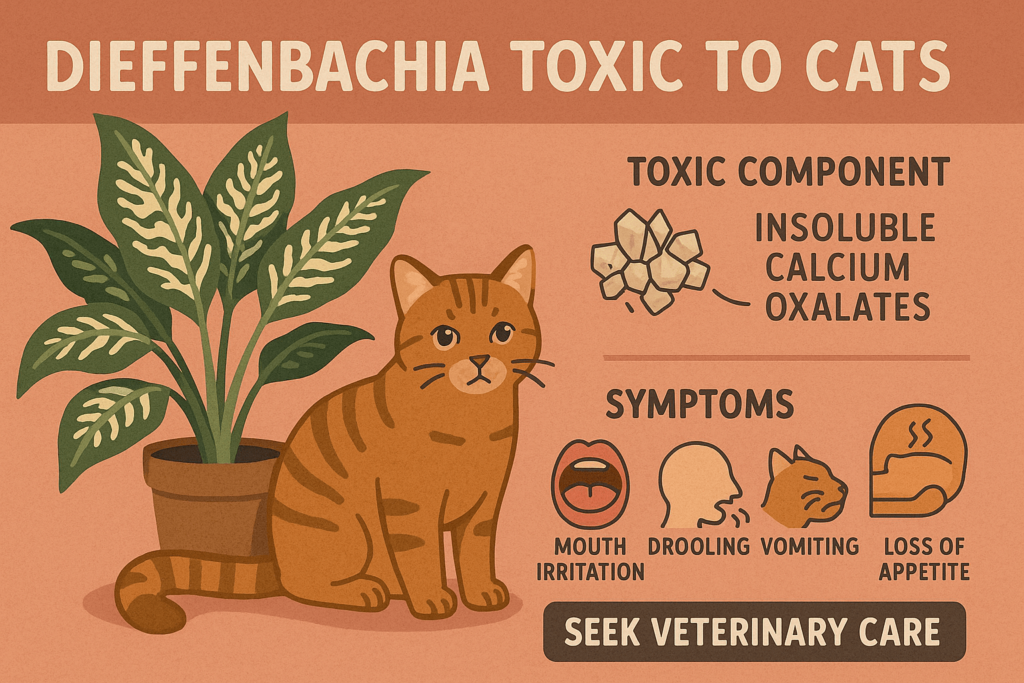
Symptoms of Dieffenbachia Poisoning in Cats
If you suspect your cat has come into contact with Dieffenbachia, recognizing the signs of poisoning early can make all the difference. Here are the most common symptoms to watch for.
Excessive Drooling:
Cats may drool profusely due to the irritation caused by calcium oxalate crystals in their mouth.Pawing at the Face or Mouth:
This behavior indicates discomfort or pain as your cat tries to alleviate the irritation.Difficulty Swallowing:
Swelling in the throat can make swallowing painful or nearly impossible for your cat.Vomiting or Diarrhea:
Gastrointestinal distress often follows ingestion of the plant, signaling that toxins have entered the digestive system.Lethargy or Weakness:
As the body reacts to the poison, your cat may become unusually tired or unresponsive.
Promptly identifying these symptoms ensures you can act quickly to minimize harm and seek appropriate care for your cat.
Check this guide 👉Is Gladiolus Cat Safe? Best 7 Expert Tips!
Check this guide 👉Are Tulips Cat Safe? Best 7 Expert Tips!
Check this guide 👉Is Ranunculus Cat Safe? Best 7 Expert Tips!
Preventive Measures | Emergency Actions |
|---|---|
Keep Dieffenbachia out of reach | Contact your vet immediately after exposure |
Use cat-safe plants as alternatives | Rinse your cat’s mouth with water to remove sap |
Train your cat to avoid houseplants | Monitor for symptoms like drooling or swelling |
Place plants in inaccessible areas | Provide fresh water to prevent dehydration |
Educate family members about plant dangers | Transport your cat to the vet if symptoms worsen |
Steps to Take If Your Cat Eats Dieffenbachia
If your cat ingests part of a Dieffenbachia plant, acting swiftly can help mitigate the effects of poisoning. Follow these steps to ensure your cat receives the care they need.
Remove Any Plant Material from Their Mouth:
Gently check your cat’s mouth and remove any visible pieces of the plant to prevent further irritation.Rinse Their Mouth with Water:
Offer fresh water or use a syringe (without a needle) to gently flush out residual sap from their mouth.Call Your Veterinarian:
Describe the situation to your vet and follow their advice on whether to bring your cat in for an examination.Monitor for Symptoms Closely:
Watch for signs of swelling, difficulty breathing, or gastrointestinal upset, and report them to your vet promptly.Avoid Home Remedies Without Guidance:
Never attempt treatments like inducing vomiting without consulting a professional, as this could worsen the condition.
Taking these steps ensures your cat receives timely and appropriate care while minimizing potential complications.
Safe Alternatives to Dieffenbachia for Cat Owners
If you’re looking to brighten your home with greenery but want to ensure your cat’s safety, consider these cat-friendly plants as alternatives to Dieffenbachia.
Spider Plant (Chlorophytum comosum):
Non-toxic and easy to care for, spider plants are a great option for pet owners.Boston Fern (Nephrolepis exaltata):
This lush, hanging plant adds beauty to your space without posing a risk to cats.Areca Palm (Dypsis lutescens):
A low-maintenance palm that thrives indoors and is completely safe for pets.African Violet (Saintpaulia):
These colorful flowering plants are non-toxic and perfect for adding a pop of color to your home.Bamboo (Dracaena sanderiana):
Often sold as “lucky bamboo,” this plant is safe for cats and requires minimal upkeep.
By choosing pet-safe plants, you can enjoy the benefits of indoor greenery while keeping your feline companion out of harm’s way.
Common Mistakes to Avoid
When dealing with potentially toxic plants like Dieffenbachia, avoiding certain mistakes can save your cat from unnecessary harm. Here’s what to steer clear of.
Assuming Small Amounts Are Safe:
Even a tiny nibble of Dieffenbachia can cause significant irritation and distress for your cat.Leaving Plants Within Reach:
Cats are naturally curious climbers—placing toxic plants on low shelves or tables isn’t enough to deter them.Delaying Veterinary Care:
Waiting too long to seek help can worsen symptoms and complicate treatment. Always err on the side of caution.Using Harmful Cleaning Products Near Plants:
Some cleaning agents can mix with plant sap, increasing toxicity levels inadvertently. Stick to pet-safe cleaners.Neglecting Alternative Options:
Failing to replace toxic plants with safer choices keeps your cat at risk unnecessarily.
Avoiding these pitfalls helps safeguard your cat’s health and creates a more secure environment.
How to Cat-Proof Your Home
Cat-proofing your home involves more than just removing toxic plants. These tips will help you create a fully safe space for your feline friend.
Install High Shelves for Plants:
Place all houseplants on shelves or ledges that are completely inaccessible to your cat.Use Deterrent Sprays:
Apply pet-safe deterrent sprays around plants to discourage chewing or exploration.Provide Safe Chew Toys:
Offer plenty of engaging toys and chewable items to redirect your cat’s curiosity away from plants.Supervise Playtime Near Plants:
Keep an eye on your cat during play sessions to ensure they don’t interact with hazardous plants.Educate Family Members:
Make sure everyone in your household understands which plants are dangerous and how to handle emergencies.
With these strategies, you can create a home where both you and your cat feel comfortable and secure.
Training Your Cat to Avoid Plants
Training your cat to stay away from plants requires patience and consistency. Try these techniques to encourage better behavior.
Reward Positive Behavior:
Offer treats or praise when your cat ignores or avoids plants, reinforcing good habits over time.Redirect Curiosity:
Provide alternative activities like interactive toys or scratching posts to divert attention from plants.Use Clicker Training:
Pair a clicker sound with rewards to teach your cat which behaviors earn positive reinforcement.Create Physical Barriers:
Use plant stands, terrariums, or barriers to block access to toxic plants during training.Be Patient and Persistent:
Cats learn gradually, so maintain consistent routines and celebrate small victories along the way.
Through training and environmental adjustments, you can teach your cat to coexist peacefully with your houseplants.
Frequently Asked Questions About Dieffenbachia and Cats
What should I do if my cat eats Dieffenbachia?
Remove any plant material from their mouth, rinse with water, and contact your veterinarian immediately.
Can Dieffenbachia kill a cat?
While rare, severe cases involving airway swelling can be life-threatening if untreated. Always seek veterinary care.
How long does it take for symptoms to appear?
Symptoms typically occur within minutes to hours after exposure, depending on the amount ingested.
Are all parts of the Dieffenbachia plant toxic?
Yes, the entire plant contains calcium oxalate crystals, making all parts dangerous if chewed or swallowed.
What plants are safe for cats?
Spider plants, Boston ferns, and African violets are examples of non-toxic plants that won’t harm your cat.
Creating a Safe Environment for Your Cat
Dieffenbachia’s striking appearance may tempt you to include it in your home decor, but its toxic nature makes it a risky choice for households with cats. By understanding the dangers, recognizing the symptoms of poisoning, and taking preventive measures, you can protect your furry friend from harm. Opting for cat-safe plants and staying vigilant about your cat’s surroundings ensures a harmonious balance between your love for greenery and your pet’s well-being. Remember, a little caution goes a long way in creating a safe and happy home for your beloved companion.
How to Find a Lost Cat: Best 7 Expert Tips! Discover actionable strategies to locate your missing cat, understand their behavior, and prevent future escapes with expert advice.
Is Dieffenbachia Toxic to Cats? Best 7 Expert Tips! Discover the dangers of Dieffenbachia, symptoms of poisoning, and how to keep your cat safe with expert advice and preventive measures.
Lentigo in Cats: Best 7 Expert Tips! Discover expert advice on understanding, identifying, and managing lentigo in cats to ensure your feline's health and happiness.
Siamese Cat Lifespan: Best 7 Expert Tips! Discover how to maximize your Siamese cat’s longevity with expert advice on health, care, and lifestyle for a happy, thriving feline companion.

